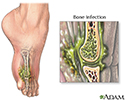Osteomyelitis - discharge
Bone infection - dischargeYou or your child has osteomyelitis. This is a bone infection caused by bacteria or other germs. The infection may have started in another part of the body and spread to the bone.
Osteomyelitis
Osteomyelitis is a bone infection. It is caused by bacteria or other germs.

At home, follow your health care provider's instructions on self-care and how to treat the infection. Use the information below as a reminder.
When You're in the Hospital
If you or your child was in the hospital, your surgeon may have removed some infection from your bones or drained an abscess.
What to Expect at Home
The provider will prescribe medicines (antibiotics) for you or your child to take at home to kill the infection in the bone. At first, the antibiotics will likely be given into a vein in the arm, chest, or neck (IV). At some point, your provider may switch the medicine to antibiotic pills.
IV
Intravenous means "within a vein. " Most often it refers to giving medicines or fluids through a needle or tube inserted into a vein. This allows th...
While you or your child is on antibiotics, your provider may order blood tests to check that the dose of antibiotic is ideal and to determine if there are any adverse effects of the antibiotics.
The medicine will need to be taken for at least 4 to 6 weeks. Sometimes, it may need to be taken for several more months.
Self-care
If you or your child is getting antibiotics through a vein in the arm, chest, or neck:
Vein in the arm, chest, or neck
You or your child will be going home from the hospital soon. Your health care provider has prescribed medicines or other treatments that you or your...

- A nurse may come to your home to show you how, or to give you or your child the medicine.
- You will need to learn how to care for the catheter that is inserted into the vein.
Care for the catheter
You have a peripherally inserted central catheter (PICC). This is a tube that goes into a vein in your arm. It helps carry nutrients or medicine in...
Read Article Now Book Mark Article - You or your child may need to go to the provider's office or a special clinic to receive the medicine.
If the medicine needs to be stored at home, be sure to do it the way your provider told you to.
You must learn how to keep the area where the IV is clean and dry. You also need to watch for signs of infection (such as redness, swelling, fever, or chills).
Make sure you give yourself the medicine at the right time. Do not stop the antibiotics even when you or your child begins to feel better. If all of the medicine is not taken, or it is taken at the wrong time, the infection may come back. Also, the germs may become harder to treat.
If you or your child had surgery on the bone, a splint, brace, or sling may need to be worn to protect the bone. Your provider will tell you whether you or your child can walk on the leg or use the arm. Follow what your provider says you or your child can and can't do. If you do too much before the infection is gone, your bones may get injured.
If you or your child has diabetes, it is very important to keep your or your child's blood sugar under control.
Keep your or your child's blood sugar u...
When you have diabetes, you should have good control of your blood sugar (glucose). If your blood sugar is not controlled, serious health problems c...

Once the IV antibiotics are completed, it is important that the IV catheter is removed.
When to Call the Doctor
Contact your provider if:
- You or your child has a fever of 100.5°F (38.0°C), or higher, or have chills.
- You or your child is feeling more tired or ill.
- The area over the bone is redder or more swollen.
- You or your child has a new skin ulcer or one that is getting bigger.
- You or your child has more pain around the bone where the infection is located, or you or your child can no longer put weight on a leg or foot or use your arm or hand.
References
Dabov GD. Osteomyelitis. In: Azar FM, Beaty JH, eds. Campbell's Operative Orthopaedics. 14th ed. Philadelphia, PA: Elsevier; 2021:chap 21.
Krogstad P. Osteomyelitis. In: Cherry JD, Harrison GJ, Kaplan SL, Steinbach WJ, Hotez PJ, eds. Feigin and Cherry's Textbook of Pediatric Infectious Diseases. 8th ed. Philadelphia, PA: Elsevier; 2019:chap 55.
Shah SS. Osteomyelitis. In: Kliegman RM, St. Geme JW, Blum NJ, et al, eds. Nelson Textbook of Pediatrics. 22nd ed. Philadelphia, PA: Elsevier; 2025:chap 725.
-
Osteomyelitis - illustration
Osteomyelitis is infection in the bones. Often, the original site of infection is elsewhere in the body, and spreads to the bone by the blood. Bacteria or fungus may sometimes be responsible for osteomyelitis.
Osteomyelitis
illustration
Review Date: 8/29/2024
Reviewed By: Jatin M. Vyas, MD, PhD, Roy and Diana Vagelos Professor in Medicine, Columbia University Vagelos College of Physicians and Surgeons, Division of Infectious Diseases, Department of Medicine, New York, NY. Also reviewed by David C. Dugdale, MD, Medical Director, Brenda Conaway, Editorial Director, and the A.D.A.M. Editorial team.


